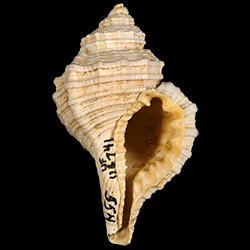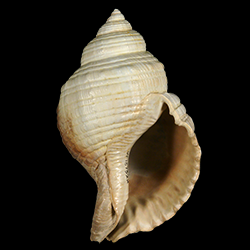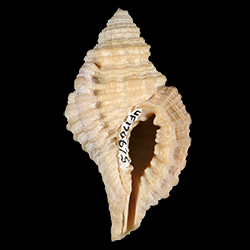
Ranellidae

- Phylum: Mollusca
- Class: Gastropoda
- Order: Littorinimorpha
- Family: Ranellidae
Overview
Common name: Triton shells
Key morphological features: The Ranellidae are small to large (to ~500 mm) sized gastropods with robust, moderate to high-spired, fusiform shells. The shell exterior features thin to wide spiral cords that in some species are crossed by axial ribs or knobs, which in the former case sometimes produce a cancellated appearance. Ranellid shells also have prominent varices. The aperture is sub-oval in outline, becoming narrower towards the anal canal at the posterior end and the siphonal canal at the anterior end. The siphonal canal can be long or short depending on the species. The interior shell lip features one or two rows of teeth that sometimes are bifid, and continue on the columellar side of the aperture in many species. The shells also have a parietal shield, but its thickness and extent are variable between species. Source: Davies, A.M. 1971. Tertiary Faunas Vol. 1, second edition. New York: American Elsevier Publishing Company, Inc. 571 pp.; Tunnell Jr., J.W., Andrews, J., Barrera, N.C., Moretzsohn, F. 2010. Encyclopedia of Texas Seashells. College Station: Texas A&M University Press. 512 pp.
Geological range: Upper Cretaceous to Recent (Davies, 1971).
Geographic distribution: A distributional map for modern Ranellidae may be accessed from OBIS. A distributional map for ancient Ranellidae may be accessed from the Paleobiology Database.
Diversity: There are 141 recognized living species of Ranellidae and 22 genera (WoRMS database, unvetted). The Paleobiology Database recognizes 38 fossil genera and 325 fossil species of Ranellidae (unvetted).
Paleoecology: The Ranellidae are epifaunal, carnivorous, marine gastropods. They feed on a variety of associated marine invertebrates, including echinoderms and tunicates, and will also scavenge carrion. They can be found on both soft and hard substrates at depths ranging from intertidal to the continental shelf. Many species are widely distributed geographically, largely due to a long, planktotrophic, veliger life stage lasting about three months. Source: Tunnell et al. (2010).
Phylogenetic status: Unknown.

